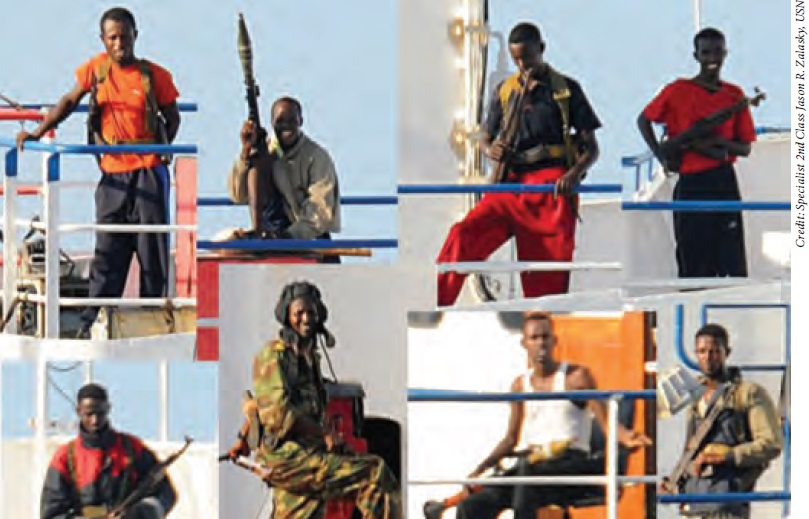[*This article was original published in the May 2013 issue of Marine Matters. It is reprinted here with the permission of the publisher, Mr. Aldert van Nieuwkoop.]
Piracy has been a fact of the maritime world since ancient times. Merchantships are the products, conveyors and producers of great wealth. They are tempting targets for criminals out to make a really big score. Worrisome trends in the shipping industry indicate that the problems of piracy may be about to worsen.
For most Canadians, piracy is a strange and remote event that occasionally gets a mention on the evening news. We shouldn’t be so smug. For three hundred years, piracy was an ongoing problem off the shores of what eventually became Canada. Harold Horwood’s book, Plunder and Pillage: Atlantic Canada’s Brutal and Bloodthirsty Pirates and Privateers, describes the glittering profits. At a time when the average annual wage of a labouring man was only ten pounds sterling, a deckhand’s share was often a thousand pounds. Life in this age was hard and death was a constant companion, but the rewards made the risk worthwhile.
There are still places in our modern world where lawlessness and the cheapness of life make taking great risks for huge rewards worthwhile. The International Maritime Bureau Piracy Reporting Centre runs a 24-hour manned reporting centre and provides on-line reports of piracy. Since its establishment in 1992, the IMB has been gathering data, providing warnings to mariners and suggesting best management practices for ship operators. Their latest advice on avoiding Somali pirates is BMP Version 4, dated 18 August 2011. Despite these measures and many others, the IMP website indicates there have been over 100 attacks worldwide and four hijackings of merchant ships this year (2013 data).
As ships’ sizes increase, so do the financial impacts of losses to pirates. The One Earth Future Foundation report “The Economic Cost of Somali Piracy in 2011” claimed losses mounted to between $6.6 and $6.9 billion. Naval patrols, private armed security teams, passive security measures, and avoidance routing have all contributed to a general decrease in the number of successful hijackings. An unintended consequence of this success has been higher ransoms demands by pirates for the ships that they do capture.
Bloomberg News reported a 36-fold increase in Somali pirate random demands between 2005 and 2011. They anticipate this trend to continue. Another worrisome trend is reports of the increased the use of firearms and physical violence against the crewmembers of hijacked ships. The length of time ships are held before ransoms are paid is also increasing. While none of this is good news, there are reasons for optimism.
Two hopeful notes about avoiding piracy have been raised. In January 2013 Tom Nevin reported in African Business “To date, not a single ship with armed security personnel aboard has been successfully pirated.” Nevin regards the use of security teams as a “game changer” in the struggle against piracy and a key factor in the 75 percent drop in attacks between 2011 and 2012. Additionally, the IMB’s report on best management practices states in Section 3.4, “To date, there have been no reported attacks where pirates have boarded a ship that has been proceeding at over 18 knots.” So, either security teams or moderate speed has been uniformly successful. Problems did not take long to arise.
In May 2012, Robert Wright reported in CNBC’s Financial Times that the high cost of fuel was inducing ships to reduce speed, even in pirate operating areas, and rely on armed security teams to provide protection. The indirect consequence of this will be to heighten the likelihood of violent confrontations between increasingly desperate pirates and armed guards. While most observers agree that the political, social and economic issues ashore in Somali will need to be rectified before the problems of piracy off the coast will be solved, the risk in confrontations at sea will be borne mainly by Somali youths that make up the majority of the attackers.
Child Pirates is a term that I helped coin in my early work with the Dalhousie Marine Piracy Project. While there is great resistance in some circles to equating of child soldiers with child pirates, it is clear that an abundance of poor and uneducated youth from a failed society that places little value on an individual’s rights is still the magic formula that spawns a culture of crime, either on land or at sea. All that is needed for this toxic mix to cause trouble is opportunity.
Enter the practice of slow steaming. The recession of 2009 is still reverberating around the maritime world and one of its outcomes has been the reduction of speed to save money on fuel. A report in The Economist in August of 2012 recorded between a 60 and 80 percent drop in the price for large containerships and tankers due to a glut in the market caused by industry losses. The desperate situation causes some operators to reduce speed to below 15 knots, which the article states, “is damaging the giant engines designed to be operated at a higher rate.” Reducing speed in pirate danger areas will induce attacks, which will necessitate the presence of security forces, who will have to employ force to carry out their mission.
A survey conducted by MAN PrimeServ in late 2011 entitled “Slow Steaming Practices in the Global Shipping Industry,” reported “customers are generally positive to slow steaming.” It showed the damage caused to main engines can be accommodated by a combination of increased servicing, fuel changes, staff training and engine upgrades. While increases in profit can be balanced off by accepting slower delivery times, the report makes no mention of customers’ views on increased vulnerability to pirates.
Eventually, ships will be built with engines that operate more efficiently at slow speeds. This will mean they will not have the option of resorting to increased speed for pirate evasion. The sole certain means of protection will become security teams. Will the cost for maritime security teams simply be added to the cost of merchandise on the shelf? It probably already is.



